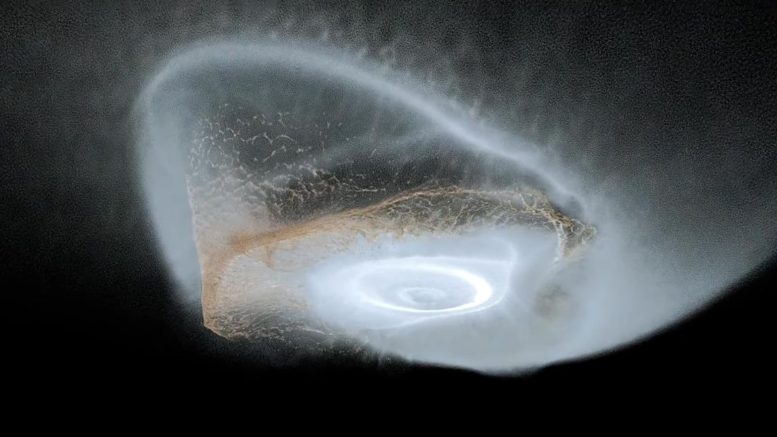
Supercomputer simulations suggest that Saturn’s rings might have originated from a massive collision between two icy moons during the age of dinosaurs. Collaborative research by NASA utilized the DiRAC supercomputing facility to simulate potential moon collisions, revealing that various scenarios could disperse the right amount of ice into Saturn’s Roche limit to form its distinctive rings. While many questions remain, including the potential for life on Saturn’s moons, this research has opened new avenues for understanding the Saturn system. Credit: NASA/Durham University/Glasgow University/Jacob Kegerreis/Luís Teodoro
Saturn’s rings may have formed from a collision between two icy moons millions of years ago, according to supercomputer simulations by NASA. This discovery provides new insights into the Saturn system and poses questions about potential life on its moons.
On a clear night, with a decent amateur telescope, Saturn and its series of remarkable rings can be seen from Earth’s surface. But how did those rings come to be? And what can they tell us about Saturn and its moons, one of the potential locations NASA hopes to search for life? A new series of supercomputer simulations has offered an answer to the mystery of the rings’ origins – one that involves a massive collision, back when dinosaurs still roamed the Earth.
According to new research published on September 27 in The Astrophysical Journal by NASA and its partners, Saturn’s rings could have evolved from the debris of two icy moons that collided and shattered a few hundred million years ago. Debris that didn’t end up in the rings could also have contributed to the formation of some of Saturn’s present-day moons.
“There’s so much we still don’t know about the Saturn system, including its moons that host environments that might be suitable for life,” said Jacob Kegerreis, a research scientist at NASA’s Ames Research Center in California’s Silicon Valley. “So, it’s exciting to use big simulations like these to explore in detail how they could have evolved.”
New NASA and Durham University simulations put forth a theory of the origin of Saturn’s rings and icy moons – they may have formed following a massive collision between two moons orbiting the gas giant. The simulations used in this research are some of the most detailed of their kind to study the formation of Saturn’s rings and potentially habitable icy moons. Credit: NASA/Jacob Kegerreis/Luís Teodoro
High-Resolution Simulations and New Insights
NASA’s Cassini mission helped scientists understand just how young – astronomically speaking – Saturn’s rings and probably some of its moons are. And that knowledge opened up new questions about how they formed.
To learn more, the research team turned to the Durham University location of the Distributed Research using Advanced Computing (DiRAC) supercomputing facility in the United Kingdom. They modeled what different collisions between precursor moons might have looked like. These simulations were conducted at a resolution more than 100 times higher than previous such studies, using the open-source simulation code, SWIFT, and giving scientists their best insights into the Saturn system’s history.
Saturn’s rings today live close to the planet, within what’s known as the Roche limit – the farthest orbit where a planet’s gravitational force is powerful enough to disintegrate larger bodies of rock or ice that get any closer. Material orbiting farther out could clump together to form moons.
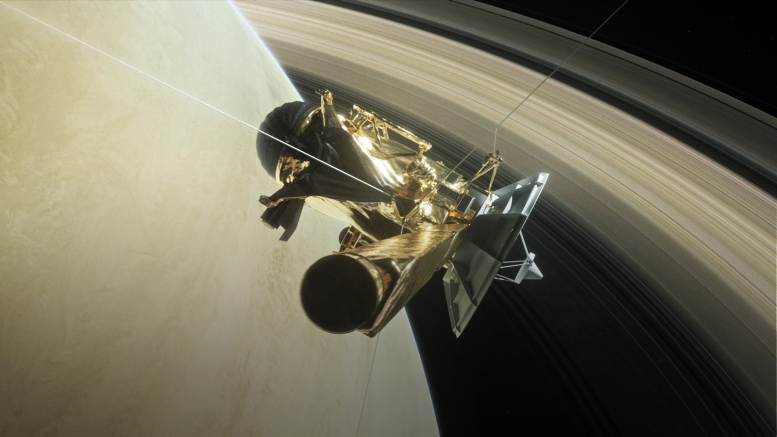
Artist’s depiction of NASA’s Cassini during its 2017 “grand finale,” in which the spacecraft dove between Saturn and its rings multiple times before purposefully crashing into the planet’s atmosphere. Credit: NASA/JPL-Caltech
The Role of Ice and Collisional Dynamics
By simulating almost 200 different versions of the impact, the team discovered that a wide range of collision scenarios could scatter the right amount of ice into Saturn’s Roche limit, where it could settle into rings.
And, while alternative explanations haven’t been able to show why there would be almost no rock in Saturn’s rings – they are made almost entirely of chunks of ice – this type of collision could explain that.
“This scenario naturally leads to ice-rich rings,” said Vincent Eke, Associate Professor in the Department of Physics/Institute for Computational Cosmology, at Durham University and a co-author on the paper. “When the icy progenitor moons smash into one another, the rock in the cores of the colliding bodies is dispersed less widely than the overlying ice.”
Ice and rocky debris would also have hit other moons in the system, potentially causing a cascade of collisions. Such a multiplying effect could have disrupted any other precursor moons outside the rings, out of which today’s moons could have formed.
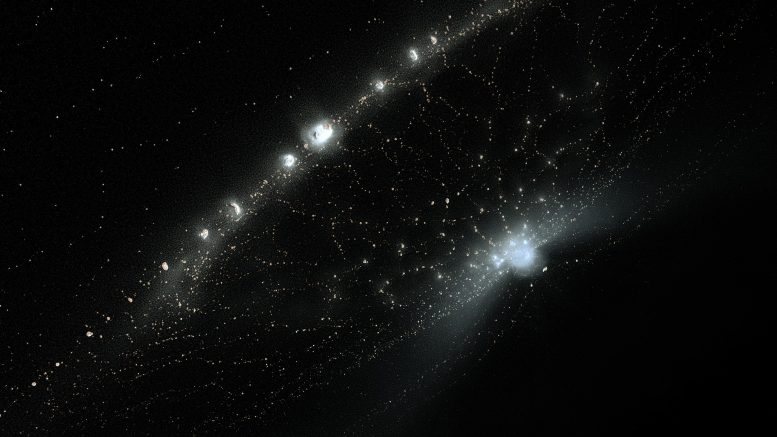
Still image from a computer simulation of an impact between two icy moons in orbit around Saturn. The collision ejects debris that could evolve into the planet’s iconic and remarkably young rings. The simulation used over 30 million particles, colored by their ice or rock material, run using the open source SWIFT simulation code. Credit: NASA/Durham University/Glasgow University/Jacob Kegerreis/Luís Teodoro
Gravitational Influences and Future Investigations
But what could have set these events in motion, in the first place? Two of Saturn’s former moons could have been pushed into a collision by the usually small effects of the Sun’s gravity “adding up” to destabilize their orbits around the planet. In the right configuration of orbits, the extra pull from the Sun can have a snowballing effect – a “resonance” – that elongates and tilts the moons’ usually circular and flat orbits until their paths cross, resulting in a high-speed impact.
Saturn’s moon Rhea today orbits just beyond where a moon would encounter this resonance. Like the Earth’s Moon, Saturn’s satellites migrate outward from the planet over time. So, if Rhea were ancient, it would have crossed the resonance in the recent past. However, Rhea’s orbit is very circular and flat. This suggests that it did not experience the destabilizing effects of the resonance and, instead, formed more recently.
The new research aligns with evidence that Saturn’s rings formed recently, but there are still big open questions. If at least some of the icy moons of Saturn are also young, then what could that mean for the potential for life in the oceans under the surface of worlds like Enceladus? Can we unravel the full story from the planet’s original system, before the impact, through to the present day? Future research building on this work will help us learn more about this fascinating planet and the icy worlds that orbit it.
Reference: “A Recent Impact Origin of Saturn’s Rings and Mid-sized Moons” by L. F. A. Teodoro, J. A. Kegerreis, P. R. Estrada, M. Ćuk, V. R. Eke, J. N. Cuzzi, R. J. Massey and T. D. Sandnes, 27 September 2023, The Astrophysical Journal.
DOI: 10.3847/1538-4357/acf4ed

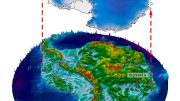

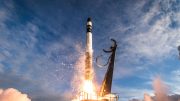

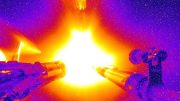
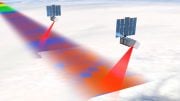
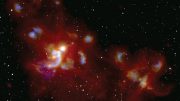

Re “If at least some of the icy moons of Saturn are also young, then what could that mean for the potential for life in the oceans under the surface of worlds like Enceladus?”
“To address these questions, an international team of astronomers created a series of high-resolution simulations coupled with improved estimates of Trans-Neptunian Object (TNO) populations. This allowed them to construct a chronology of impacts for Saturn’s most heavily cratered regular satellites – Mimas, Enceladus, Tethys, Dione, and Rhea. This established age limits of 4.1 and 4.4 billion years for all five, with the two innermost moons appearing more youthful than the outer three. These results could have significant implications for our understanding of the formation and tidal evolution of moons in the outer Solar System.” [“Whether Saturn’s Rings are Young or Old, its Moons are as Ancient as the Planet Itself”, SEPTEMBER 24, 2023 BY LAURENCE TOGNETTI, Universe Today.]